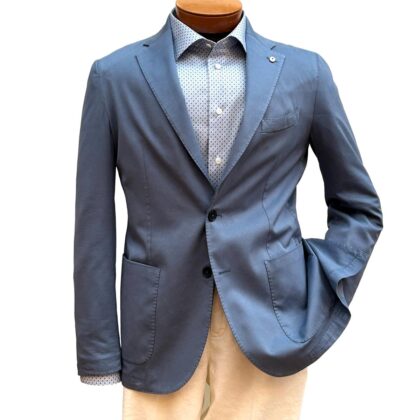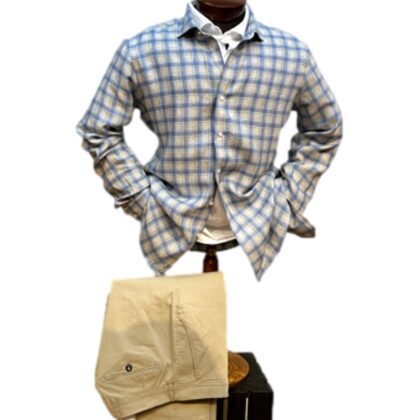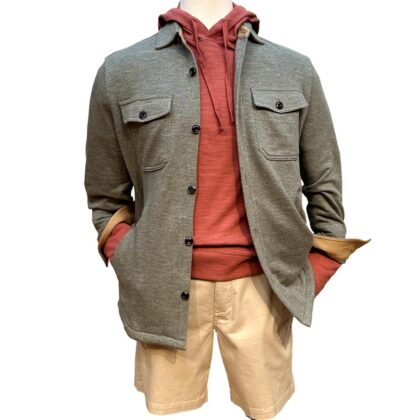Mastering Business Casual Work Attire for Men: The Essential Guide
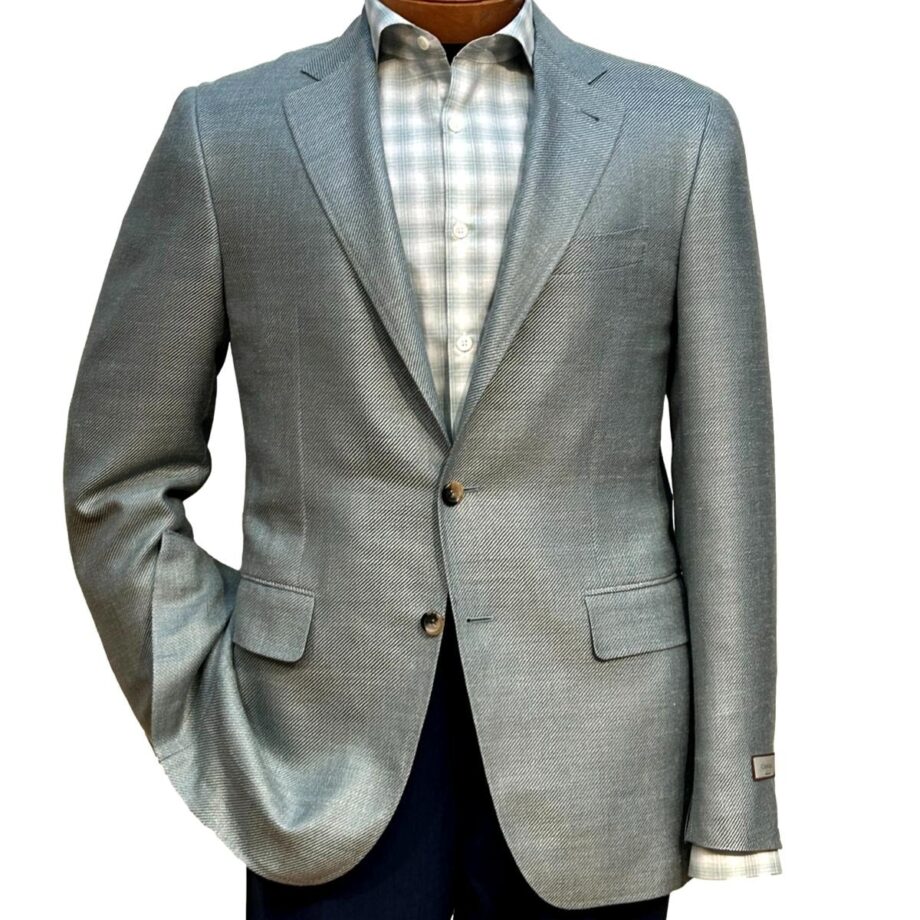
Business casual work attire for men strikes a balance between professional and relaxed, specifically tailored to suit various workplace environments. If you’re wondering what to wear to look polished and office-appropriate without being too formal, you’re in the right place. In this guide, we’ll cover essential workwear pieces, wardrobe tips, and how to dress appropriately for different professional occasions within the business casual dress code.
Men’s Business Casual Selections
-
Soft Jacket from Lubiam
$1,435.00 -
Summertime is Linen time
$613.00 -
Weekend Casual Ensemble
$394.00 -
Pique Cotton Vest for Spring
$1,110.00
Key Takeaways
- Business casual for men mixes professional and relaxed styles, focusing on polished, well-fitted outfits that reflect company culture and personal flair.
- Key wardrobe staples include well-fitted shirts, tailored trousers or chinos, and versatile blazers designed to elevate your look while ensuring comfort.
- Proper grooming and attention to detail, like clean footwear and wrinkle-free clothing, are essential for maintaining a professional business casual appearance.
Business Casual Outfits for Different Workplace Environments

Different settings may require different appropriateness. Adjusting business casual looks helps meet event expectations and prepares you for professional interactions. Outfits suitable for an office may be considered inappropriate for a formal conference.
Let’s look at specific recommendations for office settings, interviews, and work events.
Office Environment
A recommended outfit formula for men’s business casual includes:
- Navy sports coat
- White oxford shirt
- Tan chinos
- Brown oxford dress shoes
In a business casual outfit, pairing brown dress shoes with a brown belt enhances overall coordination and professionalism. Observing workplace attire norms is essential to ensure a professional appearance while fitting into the office environment.
In a more relaxed office workplace environment, you might find that casual Fridays allowing employees for a bit more flexibility, like well-fitted jeans paired with a crisp button-up shirt. However, always ensure that even in a relaxed setting, you’re maintaining professionalism and not sacrificing the polished business casual look.
Interviews
Selecting business casual attire for interviews should balance professionalism with approachability to make a strong impression. Opt for subtle patterns and traditional choices like a navy suit over a crisp white shirt.
This not only shows you mean business but also that you’re approachable and ready to fit into the company’s culture.
Work Events
Outfits for work events should reflect both the event’s formality and the organization’s culture to maintain a professional image. Consider wearing a statement shirt under a solid blazer for work events or conferences in business casual attire. This touch of flair can set you apart while still adhering to a professional dress code.
Building a Business Casual Wardrobe for Work
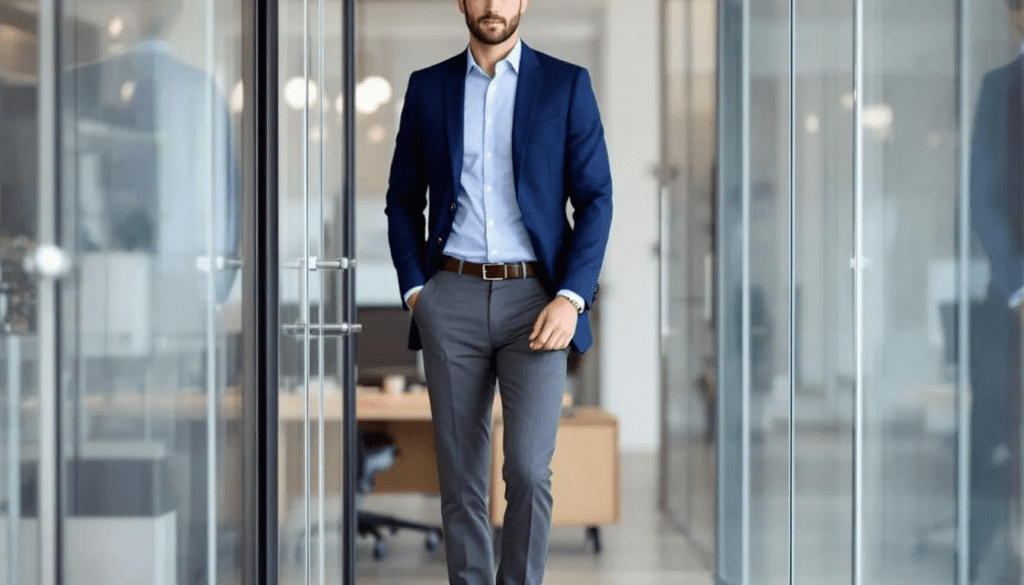
Building a business casual wardrobe for the workplace is all about investing in versatile, timeless pieces that can be mixed and matched to create a variety of looks. Essential items include:
- Well-fitted shirts
- Tailored trousers or chinos
- Comfortable shoes
- A lightweight blazer or jumper
The key to a versatile put together appearance is combining different colors and styles, aiming for a perfect blend rather than a single color outfit.
Proper fit is crucial; always ensure shirts are tucked in for a polished look, as leaving them untucked can appear disheveled. Avoid overly casual options like sneakers and distressed jeans, and opt for smart dress shoes instead.
Here are the specific elements that make up a stellar business casual wardrobe.
Dress Shirts
Dress shirts are the cornerstone of any business casual wardrobe. Crisp, well-fitted button-up shirts form the foundation of a polished look. The fit of a button-up should be perfect, hugging the shoulders and tapering at the waist without being too tight or too loose. Initial colors to consider include white and light blue, which are both versatile and professional.
Solid colors and subtle patterns, such as checks or stripes, are also recommended for button ups. More professional colors for business casual attire include:
- Navy
- White
- Black
- Grey
- Light blue
- Lavender
- Pink
For spring and summer, lighter colors and pastels like soft blues, stone, and sage are suitable. Incorporating patterns and colors is acceptable, but balance is key to avoid overwhelming combinations.
Polo Shirts
A well-fitted and structured polo shirt can be a great addition to your business casual wardrobe. Choose fitted polos in neutral colors like navy, grey, or black to maintain professionalism while offering comfort. Avoid bright colors and bold patterns to maintain a subtle and refined look.
For polos, premium double knit jersey fabrics are recommended. They provide a good balance of comfort and style. When wearing a belt, tucking in your polo shirt can earn you extra style points.
Pairing a polo with tailored trousers or chinos creates a relaxed yet polished look perfect for business casual settings.
Blazers and Sports Coats
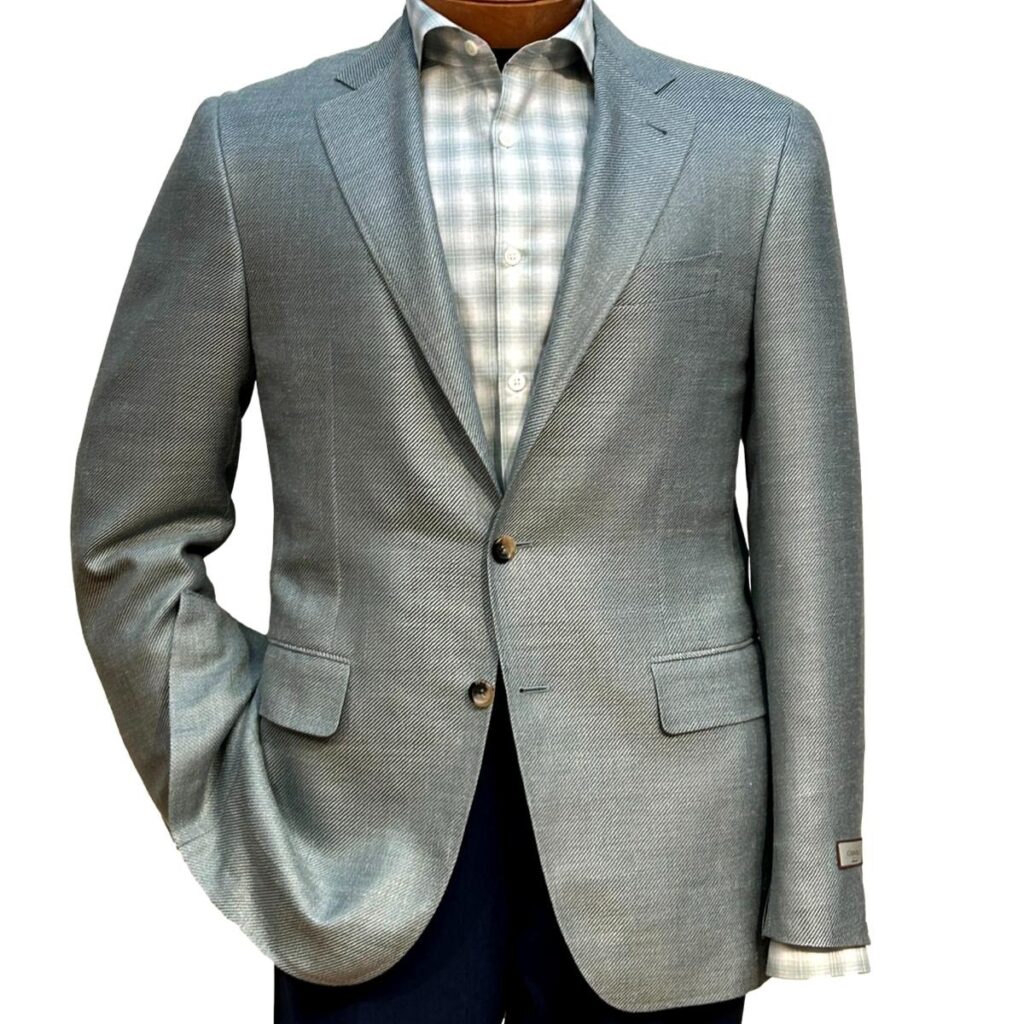
Blazers and sports coats are essential for elevating outfits in business casual settings. Adding a blazer can transform a simple business casual outfit into a polished and professional look. Layering with a charcoal blazer or sports coat enhances overall style. Recommended colors for blazers in business casual settings include:
- Beige
- Light blue
- Light grey
- White
- Coral
- Army green.
Linen blazers are particularly recommended for meetings, offering a smart yet casual appearance. A well-fitted blazer should contour to the shoulders and taper slightly at the waist. Using a pocket square can provide a stylish contrast to a blazer, adding an element of flair.
A well-fitted blazer enhances the silhouette for big and tall men. It adds polish without adding bulk.
Chinos and Dress Pants
Chinos and khakis are widely accepted as suitable for business casual attire. Trousers, chinos, and immaculate denim qualify as acceptable pants in business casual settings. Chinos are favored for their tailored yet relaxed fit, making them ideal for business casual.
Pants should remain less formal but still tailored to fit the business casual standard. Consider the following tips:
- Choose well-fitted khakis in neutral tones.
- Steer clear of casual details for a polished look.
- Suitable colors for chinos or dress slacks include navy, beige, or grey.
Avoid loose-fit pants as they tend to look too casual; seek slim or tailored fits.
Footwear
Footwear is a crucial component of men’s business casual attire. Recommended footwear includes:
- Dress shoes
- Loafers
- Minimalist sneakers
- Leather chukka boots, which are rugged yet office-appropriate
- Leather dress shoes, a classic choice for maintaining professionalism.
Colors like medium brown and minimal white are ideal for business casual shoes. Footwear should be clean, stylish, and not sports-oriented to fit business casual standards. Avoid sneakers or sandals unless explicitly permitted by office policy. Solid color leather shoes with minimal embellishment are ideal for a polished look.
Seasonal Business Casual Work Attire
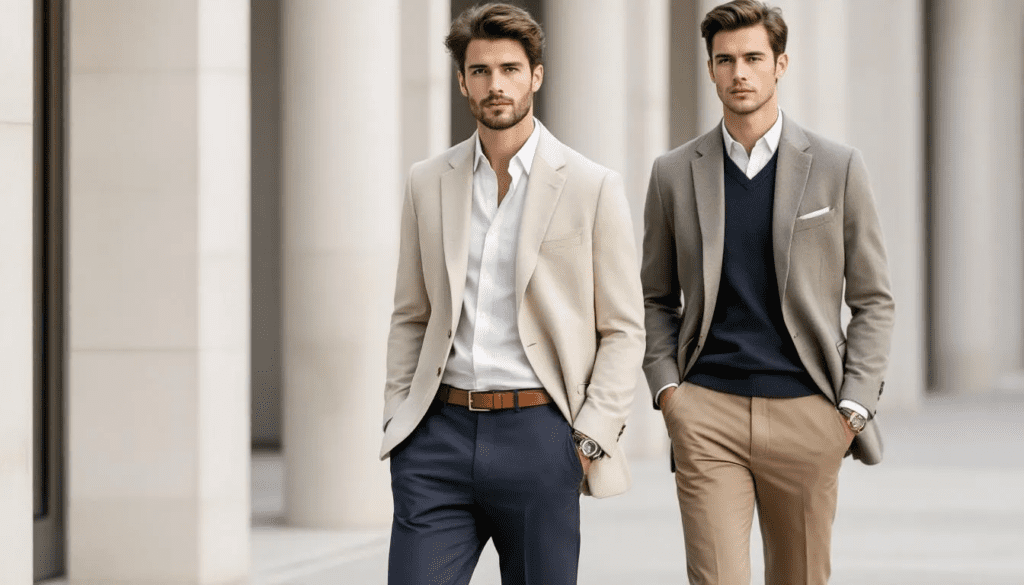
Adjusting your business casual attire with the seasons ensures comfort and style throughout the year. Seasonal adjustments are necessary to stay comfortable and stylish, whether it’s the heat of summer or the chill of winter.
Here are specific tips for spring/summer and fall/winter.
Spring/Summer

Lightweight fabrics are essential for staying cool and comfortable during the warmer months of spring and summer. Delicate fabrics such as cotton and linen are perfect for staying cool. Linen, in particular, is a lightweight and breathable fabric that keeps you cool, making it ideal for summer attire.
Choosing light colors like pastels or soft blues enhances the freshness of spring attires. Lightweight chinos or airy trousers contribute to comfort and style in warmer weather. In spring and summer, a mix of breathable fabrics and light colors helps maintain a fresh and comfortable look. Short-sleeve shirts and unlined blazers are practical choices for warmer weather.
Fall/Winter

Layering with materials like knit and flannel enhances warmth during colder months. When layering for cold weather in business casual attire, consider fit, texture, and color balance among pieces. Darker colors such as burgundy and charcoal are ideal for creating a seasonal aesthetic.
Structured outerwear like coats or jackets preserves warmth while maintaining a polished look. In colder weather, incorporating layers such as cardigans and sweaters enhances both warmth and style.
For winter, materials like wool and flannel are recommended for their insulation properties. Opting for boots and structured outerwear can keep you warm while maintaining a sophisticated appearance.
Accessorizing Men’s Business Casual Outfits
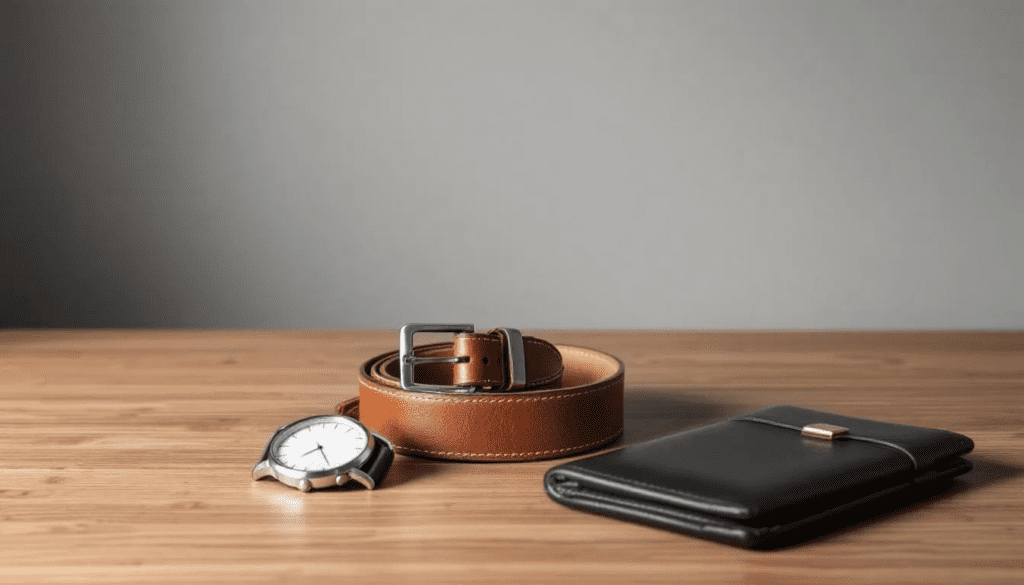
Accessories can help adjust the formality of an outfit within the business casual spectrum. They are crucial for enhancing an outfit’s overall appeal and can reflect personal style. Keeping accessories minimal, such as limiting jewelry, is recommended for a business casual look. In work events, opting for unique accessories can help you stand out while still adhering to a professional appearance.
Smart accessories enhance the look of business casual outfits without overpowering them. Let’s delve into specific accessories like watches, belts, and pocket squares.
Watches
Stylish minimal designs are recommended for wristwatches in business casual settings. Minimalist wristwatches with leather or metal straps in neutral tones are ideal choices for a business casual outfit.
A good wristwatch is essential in completing a business casual look, as it enhances both style and professionalism.
Belts
Belts should complement the color and style of shoes for a cohesive look. Whether paired with dress shoes, loafers, or even minimalist sneakers, a belt that matches your footwear can tie your entire outfit together seamlessly.
Pocket Squares
Pocket squares add a touch of personality and sophistication, enhancing the overall appearance of a blazer or sports coat. When incorporating a pocket square, consider the material, color, and pattern to ensure it complements your blazer and personal style.
Common Mistakes to Avoid
Business casual is less formal than traditional office wear but remains more polished than casual styles. One of the most common mistakes is misjudging the context of an event and dressing either too formally or too casually. Henleys and t-shirts are too casual for business casual attire. Always match your outfit to the setting to maintain professionalism.
Another frequent error is wearing items that are too casual, such as shorts or loose-fit pants. It’s crucial to avoid casual backpacks, gaudy jewelry, and novelty cufflinks, which can detract from a professional look. Grooming, neat tailoring, and confidence all contribute to a polished business casual look. Remember, maintaining a professional image requires attention to detail and understanding the event’s context.
Grooming and Maintenance
Grooming enhances professionalism and shows attention to detail. Key grooming practices include regular haircuts, beard trims, clean nails, simple skincare, and subtle cologne. Wearing wrinkled clothing can appear sloppy; always ensure clothes are pressed and wrinkle-free. Keep footwear immaculately clean to maintain an overall polished appearance and polished look.
Maintain clothing and appearance by:
- Keeping clothing clean, wrinkle-free, and well-fitted.
- Balancing professionalism in business casual attire to convey professionalism while allowing personal expression.
- Ensuring a well-groomed appearance to complement your attire and complete your polished look.
Summary
Mastering business casual work attire for men involves understanding the balance between professionalism and comfort. From building a versatile wardrobe with essential pieces like dress shirts, chinos, and blazers to adjusting your attire seasonally and accessorizing thoughtfully, each element plays a crucial role. Avoid common mistakes by paying attention to grooming and maintaining a polished appearance. By following these guidelines, you’ll confidently navigate any business casual setting, making a lasting impression with your style and professionalism.
Frequently Asked Questions
Can jeans be worn in a business casual outfit for the office?
Absolutely, jeans can work in a business casual setting if you style them right—think tailored blazers and dress shirts to keep it sharp!
What colors are best for dress shirts in business casual work outfits?
For business casual, you can’t go wrong with classic white and light blue shirts. If you’re feeling a bit bolder, navy, black, grey, pink, and lavender are also solid choices!
Are polo shirts acceptable in business casual work attire?
Absolutely, a well-fitted polo shirt in neutral colors works great for business casual! Just make sure it’s structured and looks sharp.
What footwear is recommended for business casual work outfits?
For business casual, go for dress shoes, loafers, or minimalist sneakers in medium brown or minimal white. They keep you looking sharp while staying comfy!
How should I adjust my business casual office wardrobe for different seasons?
Adjust your business casual wardrobe by opting for lightweight, light-colored fabrics in spring and summer, and layering with knits and darker colors in fall and winter. This way, you’ll stay comfortable and stylish all year round!

